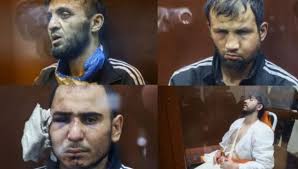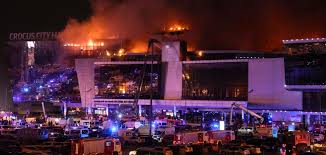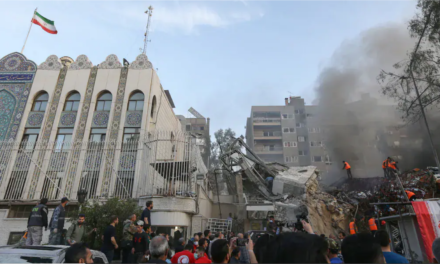The Crocus City Hall, a venue nestled in the town of Krasnogorsk outside Moscow, was meant to be a place of entertainment, music, and perhaps even community on that fateful Friday evening.
Yet, tragically, it became the scene of one of the most horrific acts of terrorism to unfold in the past two decades. The echoes of the violence that erupted within its walls on March 22nd, still reverberate through the hearts and minds of all those touched by its devastation.
Chronological timeline of the Terrorist attack
At 7:55 PM, the tranquillity of the evening was shattered as a white Renault Symbol sedan, carrying a group of armed terrorists, pulled into the parking lot of the Crocus City Hall. With callous disregard for human life, these militants stormed into the building, brandishing their weapons and unleashing a hail of bullets, first taking out the unsuspecting guards and turning on patrons within the lobby.
Panic ensued as chaos engulfed the once serene atmosphere, with some fleeing into the streets while others sought refuge wherever they could find it, even within the confines of restroom stalls or behind shattered windows.
The assault did not end there. With calculated brutality, the terrorists proceeded deeper into the building, targeting the concert hall itself. Although the performance had not yet begun, the hall was full of families waiting for the concert to start. Those present sought cover wherever they could, behind seats or cowering in corners, as the terrorists continued to slaughter anyone in their path.
With precision to plan the terrorists began throwing Molotov cocktails in the concert hall, attempting to trap as many innocent families and to maximise the death toll, turning what was meant to be a place of music into an inferno that would eventually engulf the entire concert hall resulting in the roof collapsing killing all that did not escape.
Amidst the chaos, a glimmer of heroism emerged as one brave soul disarmed one of the terrorists, creating an opportunity for others to flee to safety.
Yet, for many, safety remained elusive as the attackers swiftly fled the scene, leaving behind a trail of destruction and despair. In a last act of barbarism, the terrorist targeted a family while escaping mowing them down with the white Renault sedan, leaving 2 children fighting for life in hospital.
In a mere 18 minutes, the terrorists had inflicted immeasurable suffering upon the innocent souls gathered within the Crocus City Hall.
As the flames ravaged the concert hall, panic gave way to desperation as those trapped within searched desperately for a means of escape. The efforts of the concert hall staff, alongside the valiant efforts of emergency responders, saved many lives amidst the confusion and terror.
Ambulance crews, rescue teams, and security personnel converged upon the scene, their tireless efforts a beacon of hope amidst the darkness.
By 9:20 PM, the harrowing ordeal began to ease as EMERCOM employees evacuated survivors from both the ground floor and the rooftop, where some had sought refuge from the violence below.
Helicopters buzzed overhead, battling the inferno that threatened to consume the building in its entirety. Yet, even amidst the relief of rescue, the grim reality of the situation remained. The roof, now engulfed in flames, posed a dire threat to any who may still be trapped within.
By 10:00 PM, as the flames continued to rage, the Investigative Committee of Russia announced the initiation of a criminal case, signalling the beginning of a long and arduous journey towards justice for the victims and their families. The rubble that once was the Crocus City Hall became a grim testament to the horrors unleashed by those who seek to sow fear and discord.
The trail of evidence led law enforcement officials to a vehicle—a white Renault sedan—that served as both the means of transportation and the getaway vehicle for the perpetrators of the attack. Reports suggested that this vehicle was spotted heading west along the Kiev highway in the aftermath of the murders, its occupants fleeing the scene of devastation they had wrought.
As the hours passed, the hunt for the terrorists intensified. Soon, a breakthrough emerged when authorities identified a car matching the description of the white Renault Symbol in the Navlinsky district of the Bryansk region approximately 100 km from the border with Ukraine.
However, any hopes of a peaceful apprehension were dashed when the driver of the vehicle failed to comply with law enforcement’s orders to stop. In response, security forces were forced to take drastic action, resorting to opening fire on the vehicle’s wheels in a bid to immobilize it.
Who the Terrorist are
Subsequent investigations and intelligence reports from the Federal Security Service (FSB) revealed chilling details about the individuals involved in orchestrating the attack. It was disclosed that there were four direct participants in the terrorist operation, all of whom were occupants of the Renault Symbol. These individuals were identified as Fayzov Muhammadsobir, Fariduni Shamsutdin (deemed the ringleader), Saidakrami Rachabalizoda, and Dalerjon Mirzoev, all citizens of Tajikistan.

The age range of the suspects varied, with the youngest being a mere 19 years old and the oldest at 32. Language barriers further complicated matters, as it was revealed that, with the exception of Fariduni, the detainees did not speak Russian. This linguistic isolation likely served to further alienate them from the society they targeted with their violence.
During interrogation, the detainees confessed to their involvement in the attack, shedding light on the sinister motivations and planning behind the atrocity. They revealed that the weapons used in the assault had been acquired from a hidden cache, the location of which had been disclosed to them by their handlers. These handlers, or “curators,” had promised a substantial sum of money—approximately 500 thousand rubles—as compensation for their role in organizing and executing the attack.
The scope of the investigation widened as authorities began to piece together the network of individuals complicit in the planning and execution of the terrorist operation. In total, it was determined that 11 individuals were implicated in organizing the shooting and arson at the concert venue in Krasnogorsk, each facing severe criminal charges for their involvement in the heinous act.
In the aftermath of their apprehension, the detainees were brought before the Basmanny Court of Moscow, where they faced the gravity of their crimes. Despite their initial denial of responsibility, all four suspects detained in the Bryansk region ultimately confessed to their roles in the attack. Their admission of guilt served as a sobering reminder of the depth of depravity to which some individuals can sink in pursuit of their malevolent agendas.
With the perpetrators now in custody, the focus shifted to ensuring that justice would be served for the victims of the Crocus City Hall terrorist attack. Yet, even as the wheels of justice began to turn, the scars left by this senseless act of violence would endure, serving as a haunting reminder of the fragility of peace and the ever-present threat posed by those who seek to sow chaos and destruction.
The heinous act of terror that unfolded at the Crocus City Hall on that fateful Friday evening didn’t just materialise out of thin air; it was meticulously planned and executed by individuals with sinister intentions.
The toll of the attack was staggering. 137 lives, including 3 innocent children, were tragically cut short, while countless others were left wounded and traumatized. The scale of the tragedy sent shockwaves rippling not only through the town of Krasnogorsk but throughout the entirety of Russia and beyond.
Russian President Vladimir Putin, in a sombre address to the nation on March 23rd, offered his heartfelt condolences to all those affected by the senseless violence. He declared March 24th a national day of mourning, a solemn occasion to honour the memory of the victims and to stand in solidarity with their grieving families. Additionally, he vowed to implement stringent anti-terrorist measures to prevent such atrocities from ever happening again.
The response to the tragedy was swift and resolute. Spontaneous memorials sprung up across Moscow and other cities, as citizens gathered to pay their respects to the fallen. From distant shores, leaders of nations around the world offered their condolences and condemned the cowardly act of terrorism that had claimed so many innocent lives.
In the face of such unspeakable evil, the resilience of the human spirit shone through. Though the scars left by the attack may never fully heal, the outpouring of support and solidarity from around the world served as a powerful reminder of the strength and compassion that unite us all in times of crisis.
As the sun set on the shattered remnants of the Crocus City Hall, a nation mourned its losses, but also stood united in defiance against those who seek to tear us apart. Though the road ahead may be long and fraught with challenges, we must never waver in our commitment to justice, to peace, and to the enduring belief that love will always triumph over hate.





